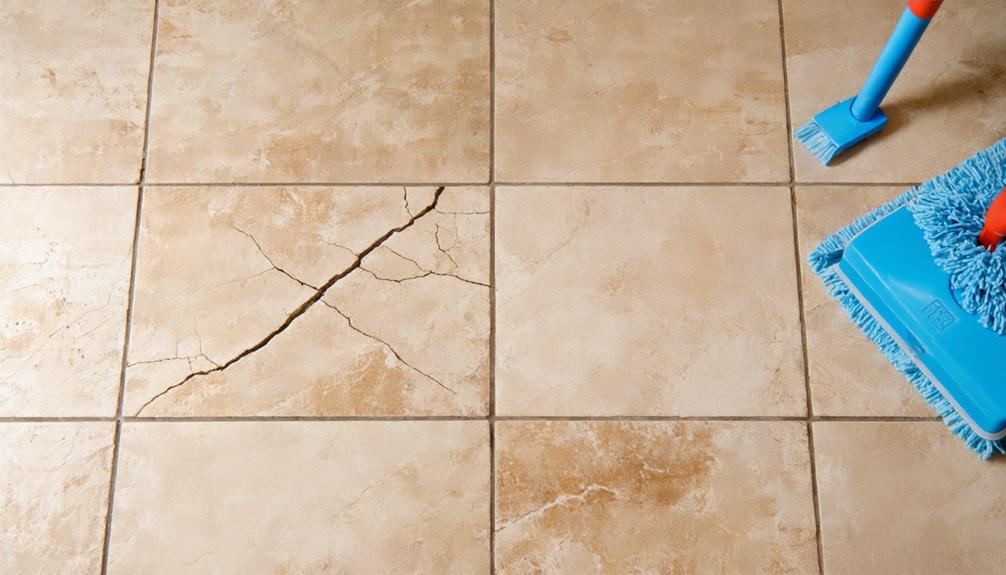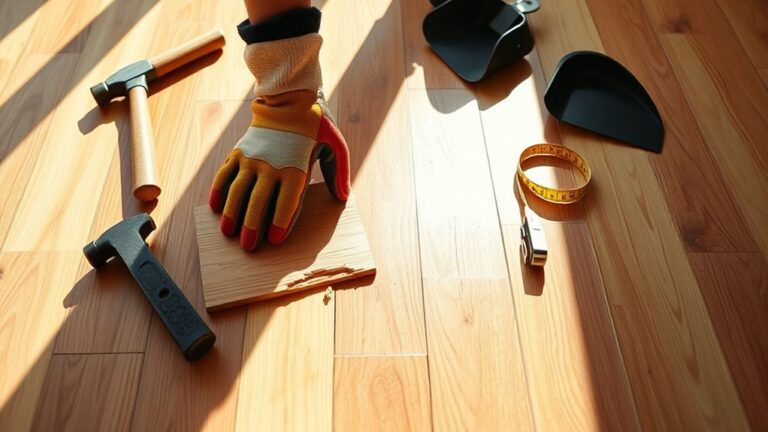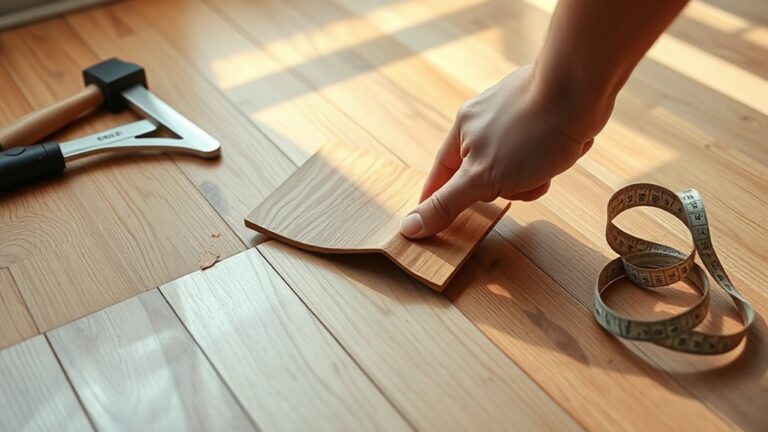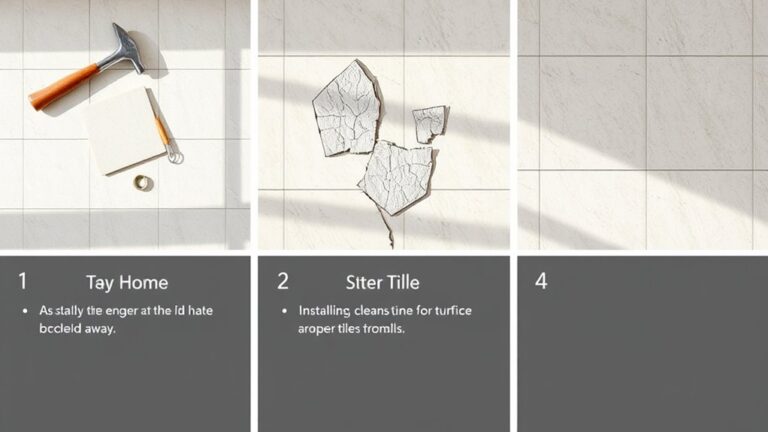Travertine floors can face several common problems that affect their durability and aesthetics. Their porous nature makes them prone to stains, especially from spills if not promptly cleaned. Acidic substances can cause etching, creating dull spots that require gentle repair. Scratches from foot traffic are also likely due to travertine's softer composition. Lippage, or uneven tile edges, can pose tripping hazards, while water damage can occur in humid environments. Regular sealing and maintenance are essential to prevent these issues and guarantee your floors remain beautiful and intact. Explore further to uncover solutions to each of these challenges.
Overview of Travertine Floors
Travertine floors offer a unique blend of beauty and durability, making them a popular choice for many homeowners. As a natural stone formed from mineral deposits around hot springs, travertine showcases earthy tones like tans, browns, rust, and beige, which can complement various design styles. When considering travertine flooring, it's vital to understand its characteristics and maintenance requirements.
One of the key features of travertine is its porous nature. This means you'll need to take extra steps in care and maintenance to protect your investment. Regularly sealing the travertine is important to prevent deep stains and preserve its integrity. Depending on the finish you choose—polished, honed, tumbled, or brushed—your flooring will have distinct aesthetic qualities. However, each finish may have different care requirements.
While travertine flooring is versatile and beautiful, it does come with common problems. Its weight can make installation in certain locations challenging, particularly in areas prone to heavy moisture, where issues with travertine can arise more frequently. Additionally, wear and tear over time can lead to surface damage if not properly maintained. Understanding these aspects will help you appreciate the advantages of travertine while being aware of the necessary precautions to protect its longevity. By committing to regular maintenance, you can enjoy the timeless elegance of travertine floors in your home for years to come.
Common Issues With Travertine
What common issues should you be aware of when considering travertine floors? First and foremost, these floors are highly porous, making them susceptible to stains from spills, dirt, and oils. This characteristic underscores the need to seal your travertine regularly to maintain its appearance. You'll also want to be cautious of etch marks, which occur from acidic substances like vinegar or citrus. Using pH-neutral cleaners can prevent these dull spots from forming.
Another concern involves scratches, especially in areas with heavy foot traffic. These scratches can result from dragging furniture or contact with abrasive materials. Implementing protective measures, such as using felt pads under furniture, can greatly help preserve your floors. Additionally, lippage, or uneven tile edges, can create tripping hazards and often stems from improper installation. This highlights the importance of hiring professionals for installation to avoid this common issue.
Water damage is another major threat to travertine floors, particularly in high-humidity areas. If excess moisture is not managed correctly, it can lead to mold and deterioration. To combat this, proper sealing and routine maintenance are essential. Being proactive about these common issues will guarantee your travertine floors remain beautiful and functional for years to come. By understanding these aspects, you can take the necessary steps to protect your investment and enjoy the natural beauty of travertine in your home.
Understanding Stains
When it comes to maintaining the beauty of your travertine floors, understanding stains is fundamental. Due to travertine's porous nature, it's highly susceptible to stains from spills, oils, and food, which can seep into the stone if not promptly cleaned. Immediate action is imperative; always blot the area instead of rubbing to prevent further penetration into the stone.
Stains from travertine can vary, but organic stains like coffee or wine can be tackled effectively with a poultice made from baking soda and hydrogen peroxide. This mixture draws out the discoloration, restoring the floor's natural beauty. Regular sealing of travertine floors every 1-3 years can greatly reduce the risk of staining by creating a protective barrier, making it essential for the longevity of your natural stone surfaces.
It's also important to be mindful of what you use on your travertine. Avoid acidic substances and cleaners, as they can not only cause etching but also exacerbate staining issues. The chemical reaction that occurs when acidic substances come into contact with the stone can lead to permanent damage, so always opt for pH-balanced cleaners.
In addition to sealing, regularly removing dirt and debris can help prevent scratches and further staining. If you encounter persistent stains, consider consulting a professional. Their expertise can help guarantee your travertine floors remain stunning and resilient over time.
Addressing Etching Problems
Etching on travertine floors primarily occurs due to contact with acidic substances, leading to unsightly dull spots. To effectively address this issue, you'll need to understand both the causes and prevention techniques, as well as restoration methods for damaged areas. By following the correct steps, you can maintain the beauty and integrity of your travertine surfaces.
Causes of Etching
Acids from everyday substances can pose a significant threat to the beauty of your travertine floors. Etching on travertine floors occurs mainly due to contact with acidic substances that react with the calcium carbonate in the stone. This reaction forms dull, white spots, damaging the surface and diminishing the stone's natural luster.
Be aware of these common acidic culprits:
- Vinegar
- Citrus juices
- Certain cleaning products
The porous nature of travertine tiles makes them particularly vulnerable, allowing acids to penetrate easily. To combat this issue, it's crucial to avoid acidic substances and maintain your floors with regular use of pH-neutral cleaners. If etching does occur, you can often repair the damage by sanding the affected areas and applying a marble polishing compound. Afterward, sealing the surface is essential to restore protection and enhance the floor's appearance. By understanding the causes of etching, you can take proactive steps to preserve the beauty of your travertine floors, ensuring they remain a stunning feature in your home.
Prevention Techniques
To effectively prevent etching on your travertine floors, it's essential to adopt a proactive approach in both cleaning and maintenance. Start by always using a pH-neutral, natural stone cleaner instead of acidic or abrasive products that can dull the surface. Regularly sealing your travertine floors every 1-3 years creates a protective barrier, considerably reducing the risk of etching from spills and acidic substances.
Be mindful of common acidic items like citrus fruits, vinegar, and certain cleaners, ensuring they're kept away from your travertine surfaces. If a spill occurs, clean it immediately with a soft cloth and warm water to prevent the liquid from penetrating the stone and causing etching. Addressing minor scratches with a polishing compound can also help maintain the shine and integrity of the surface, further reducing the appearance of etching over time.
Restoration Methods
Even with the best prevention techniques in place, travertine floors can still suffer from etching due to accidental spills or exposure to acidic substances. This common issue leads to dull spots that require immediate attention. Here are some effective restoration methods to address etching problems:
- Clean the area: Use a pH-neutral stone cleaner to remove any debris or residue.
- Sand the spot: Gently sand the affected area with fine-grit sandpaper, following the direction of the grain.
- Polish and seal: Apply a marble polishing compound to restore the shine and blend it with the surrounding tiles.
Managing Scratches and Damage
Over time, managing scratches and damage on travertine floors becomes vital to preserving their beauty and functionality. Since travertine is a softer stone, it's particularly vulnerable to scratches from heavy foot traffic or dragging furniture. To minimize this risk, always use felt pads under furniture legs.
For minor scratches, start by cleaning the area with a stone-safe cleaner or mild soap. Once the surface is clean, gently sand the scratched area using fine-grit sandpaper. This method will help to remove the scratch and restore the finish. After sanding, apply a marble polishing compound to enhance the appearance further and protect the surface.
However, if you encounter significant damage or deeper scratches, it's best to hire a professional. They'll have specialized equipment and expertise to effectively repair the travertine without compromising its integrity. Regular maintenance, including sealing your floors every 1-3 years, is essential for durability. Sealing not only protects against scratches but also reduces the likelihood of other types of damage.
Don't overlook any visible scratches; prompt attention can prevent them from becoming deeper or more pronounced. By prioritizing stone care and addressing issues as they arise, you can guarantee the longevity and beauty of your travertine flooring. This proactive approach will keep your floors looking pristine and functional for years to come.
Maintenance and Prevention Tips
Maintaining travertine floors requires a consistent approach to care and prevention to guarantee they remain beautiful and functional. By implementing a few key maintenance and prevention tips, you can preserve the natural beauty of your travertine flooring and enhance its durability.
- Regularly sealing travertine floors every 1-3 years is vital to prevent staining.
- Clean spills immediately with a soft cloth and mild soap solution to avoid setting stains.
- Use furniture pads under heavy items to prevent scratches and damage.
Start by sweeping or vacuuming regularly to keep the surface clean. Dirt and grit can cause scratches and wear, diminishing the floor's appearance. Additionally, placing doormats at entryways can trap dirt and debris, minimizing scratches and maintaining cleanliness.
When it comes to spills, prompt action is essential. Always clean spills immediately to prevent stains from penetrating the porous stone. If you have heavy furniture, avoid dragging it across the floor; instead, use furniture pads to protect the surface. These simple strategies not only maintain good traction but also help to ensure that your travertine floors remain functional and attractive for years to come.
When to Seek Professional Help
At times, travertine floors may require professional intervention to address issues beyond routine maintenance. Understanding when to seek professional help is key to preserving the beauty and longevity of your flooring.
| Issue | Reason to Seek Help |
|---|---|
| Etching | Requires specialized restoration techniques. |
| Deep Scratches | Standard polishing methods may not suffice. |
| Persistent Stains | Advanced cleaning agents are necessary. |
If you notice etching on your travertine, it's vital to consult a professional, as they can employ specialized restoration techniques to restore the surface finish effectively. Similarly, deep scratches that resist standard polishing methods indicate the need for professional restoration services equipped with the right tools and expertise.
For stains that won't budge despite your DIY efforts, professionals have access to advanced poultices and cleaning agents designed for tough stains. Additionally, if hairline cracks evolve into larger fissures, or if you see signs of water damage, it's important to consult an expert to assess the structural integrity of your flooring and prevent further deterioration.
Regular maintenance, including sealing and polishing, is best managed by professionals to guarantee your travertine maintains its aesthetic appeal and durability over time. Don't hesitate to seek assistance when these issues arise; it's a smart investment in the longevity of your travertine floors.
Frequently Asked Questions
What Are the Downsides of Travertine Flooring?
Did you know that travertine flooring averages around $15 per square foot? While its aesthetic appeal is undeniable, you need to contemplate cost and installation challenges. The porous nature makes it moisture-sensitive, requiring regular surface sealing to prevent stains. Additionally, color variations can be tricky, and there's a risk of scratching from heavy foot traffic. Finally, cleaning products must be pH-neutral to avoid etching, adding to the maintenance burden.
Are Travertine Floors High Maintenance?
Yes, travertine floors can be considered high maintenance. You'll need to implement proper cleaning methods and adhere to sealing frequency every 1-3 years to combat water absorption and stains. Their scratch resistance is limited, requiring felt pads and prompt stain removal. Additionally, be aware of temperature sensitivity, which can affect durability. While installation costs may vary, the aesthetic appeal is undeniable, making it a worthwhile investment despite the ongoing maintenance commitment.
How Long Do Travertine Floors Last?
You might think travertine floors don't last long, but their durability can reach up to 100 years with proper care. The installation process and sealing importance play significant roles in longevity. Regular sealing every 1-3 years protects against damage, while effective cleaning techniques help maintain their beauty. When considering cost comparison with other materials, travertine offers unique color variations and aligns with modern design trends, making it a lasting investment for your space.
What Not to Use on Travertine Floors?
When cleaning your travertine floors, avoid using acidic substances like vinegar solutions, as they can etch and discolor the stone. Don't use abrasive tools like scrubbing brushes or harsh chemicals, which can scratch and dull the surface. Oil-based cleaners and wax coatings should also be off-limits, as they can leave residues. Finally, steer clear of steam mops; their high heat can damage the porous travertine. Stick to gentle, pH-neutral cleaners for maintenance.




